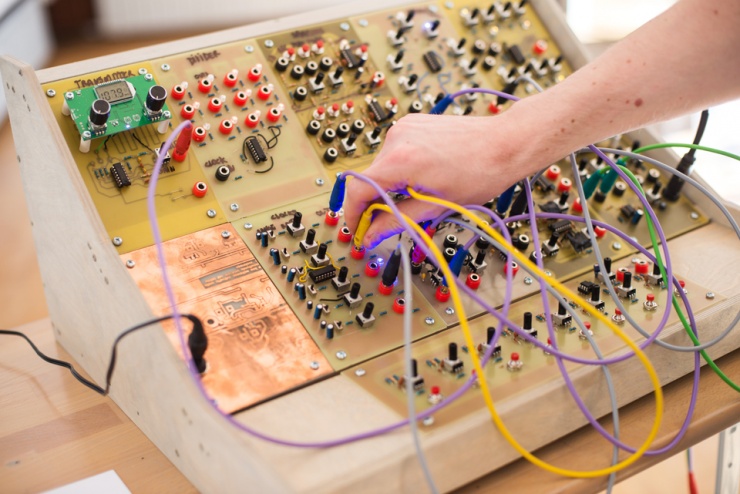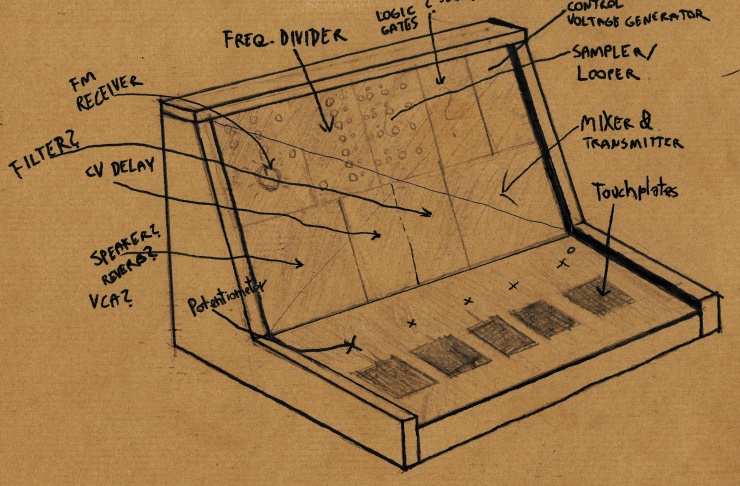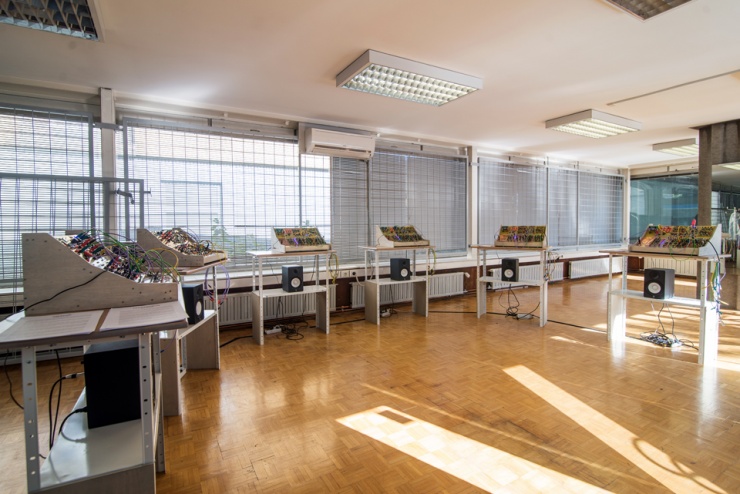Staš Vrenko: Connective
Interactive sound installation

About the project
Connective is an interactive sound installation of six electrical instruments / modular synthesizers designed for production, processing and emission of sound. Each individual modular synthesizer is composed of ten multi-functional modules, including a receiver, a transmitter, a sampler and a keyboard. Modular synthesizers feature a hybrid design that enables and combines usage of analogue and digital technique of sound synthesis. Electrical instruments, made specifically for this project, enable performers to manipulate and re-emit sound captured through radio receivers.
Connective captures the radio frequency spectrum as its source of sound and thus material for further sound processing. It simultaneously treats it as a source of data which affects the functioning of modular synthesizer's individual components. The Connective joins its participants into an interferential situation, dependent upon relations between different sound structures created, in turn, by individual participant's modulation of radio input, responsiveness to other performers and selection of transmission frequency. Emerging sound microclimates are a result of each individual's decisions in controlling their own sound and forming a responsive network through mutual interaction.
One can hear the Connective's constant flow of sound information through various channels. Inside the radio network the performers are connected by sound emitted through the transmitter on a selected frequency into the radio spectrum. It is feasible to hear this sound using portable FM receivers within the Connective's transmission range. Listening to the sound-scape will be made possible by amplification of individual modular synthesizers through speaker systems inside the gallery space. The programme of (mostly) commercial radio stations is thus used as raw material, a sound screen, which goes through a comprehensive electronic transformation during the performance. The Connective gathers its performers into a dynamic radio network which forms an omni-directional communication flow. The radio network, created through such participation, is engaged in different forms of sound feedback loops while simultaneously unravelling itself, capturing, transforming and re-emitting various bits of radio signal.
The Connective transforms the structure of the mundane ecology of the FM radio networks, an apparatus of hyper-developed culture of the commercial spectacle, by manipulating it. With the techno-ludistic appropriation, performers occupy different radio stations through temporary control of location, texture and context of the medium. The roles of performer – listener and transmitter – receiver form a network of transient relations inside the temporary situation. Such situation represents an open, undetermined organization of sound synthesis creators and visitors listeners. The micro-particularities of relations inside a temporary organization as opposed to mass consumerism and omnipresence of the market are mirrored through the set-up.
The undeterminable nature of the sonic situation questions the elements of participatory observation and performativity (participation in a certain situation and/or event - experience), and the assessment of its meaning and its significance within a broader context (interpretation). It also provides a possibility of unsettling the normative concepts of reality, actuality, truth and knowledge. The invisible mobility of the sound persists with the lasting principle of here and now and plays a very important role in the perception of the public space and the forms through which it is generated. The system highlights the participants of this process not as creators of grand narratives, but rather micro-narratives, which are ephemerally omnipresent in the background of individual perceptions creation.
The "modularly synthetic" situation of the Connective can be understood as assuming a position of dissensus communis. Under the notion of dissensus communis we do not merely assume the basic common judgement which enables "normal" social communication. The domain of dissensus communis also contains opinions and informal norms internalized by the society without exposing them to critical reflection. As an artistic posture, dissensus communis is based on critical reflection encompassing a certain form of "hysterization" of the consensual public sphere and the exposure of internal tensions normally masked by the social consensus. The system and its participants introduce dissensual signifiers into the public space (FM spectrum) by becoming the subjects of a different articulation and performativity.
With open procedures of material and media transformation, the participatory event Connective comments on its relation towards commercial culture programme and commoditisation of public goods through deconstruction of the privileged discourse. In this way it creates dissensus through a new frequency space, within which various signals flow into a temporarily integrated sound-spatial corporeality-circuit. The Connective is a system providing a cooperative basis for the scrutiny of existing collective and individual relationships within social communication systems, for creation of temporary communities and exploration of possible transmission technology transformation.
Text by Lenka Đorojević
Past events
- Pixxelmusic 2019, Nova Gorica, November 15 2019
- Performance at Kiblix Festival | 16 November 2017 at 8 PM | Performers: Jaka Berger – Brgs, Blaž Božič – SsmKOSK, Aleš Hieng – Zergon, KIKIRIKI, Mono Scarves (Klemen Šali) and Samo Pavlica – Linč.
- Sonica Festival 2016 | Installation and performance by Vitja Balžalorsky, Jaka Berger – BRGS, Blaž Božič – SsmKOSK, Aleš Hieng – Zergon, Kikiriki and Samo Pavlica – Linč | 30 September – 10 October 2016
About the author
Staš Vrenko (1991) born in Ljubljana, Slovenia. Graduated at the Academy of Fine Arts and Design in Ljubljana, where he is continuing his master studies at the Sculpture Department. His interdisciplinary artistic practice combines exploration of various artistic fields with process orientated research, uncovering many different technological and medium- related specifics of the material he is working with, while focusing on innovative and original approaches in various aspects of sound, sound design, field recording, kineticism and segments of performative arts. Beside his independent work in the field of sound art, he is also a member of the audio-literary group nevem nevem.
He often collaborates with other artists, producing sound designs for videos and installations and has worked as a set designer for theatre shows. He has exhibited at several group exhibitions: at the international Lighting Guerilla Festival at the Vžigalica Gallery (2012), at the exhibition 4.4. in Ljubljana's Škuc Gallery (2013), at the U3 | 7th Triennial of Contemporary Art in Slovenia | Resilience at the Museum of Contemporary Art Metelkova in Ljubljana (2013) and at the STIK/H exhibition for Days of poetry and wine at the Fürst house in Ptuj (2013). He presented his audio-visual performances at AKC Metelkova Mesto in Ljubljana and Sokolski dom in Škofja Loka (2014), at the Ljubljana's Strictly Analog festival (2015) and the Lighting Guerrilla Festival (2016). He has held solo concerts at the Young Rhymes Festival in Menza pri koritu (AKC Metelkova mesto Ljubljana), held a live radio-concert for Radio Student (Ljubljana) and has held solo concerts at Pritličje and Modri Kot in Ljubljana (all in 2015).
Concept and realization: Staš Vrenko
Curator: Lenka Đorojević
Technical advices, open source schematics: Luka Frelih, Peter Edwards aka Casperelectronics, Michael Page, Dave LeBleu, Scott Gravenhorst, Nicolas Collins, Elliot Williams and Logic noise, Electro-Music (Lunettas - circuits inspired by Stanley Lunetta) and Muff-Wiggler forum
PCB assembly: Blaž Božič, Luka Frelih, Tina Dolinšek, Maja Burja, Urška Aplinc
Support and help: Maja Burja, Vesna Obid, Marij Vrenko, Maj Vrenko, Blaž Božič, Matej Stupica, Tina Dolinšek, Uroš Veber
Performers: Blaž Božič – Boško, Samo Pavlica – Linč, Kikiriki, Jaka Berger – Brgs, Vitja Balžalorsky, Aleš Hieng – Zergon
Production: Ljudmila Lab and Projekt Atol Institute
Co-production: MoTA – Museum of Transitory Art | Festival SONICA
Project is supported by the Slovene Ministry of Culture and MOL – Department for Culture.


